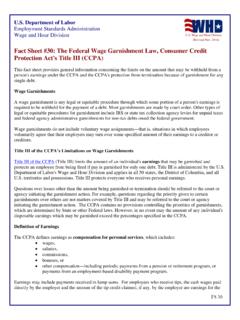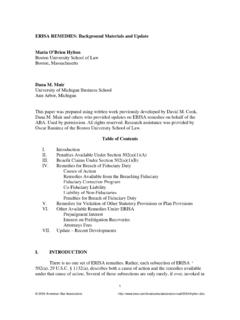Transcription of AMERICA’S SKILLED WORKERS CRISIS - Center for America
1 28 | view this issue at | JOHN RATZENBERGER, SENIOR FELLOW, Center FOR AMERICAI mpact on the wholesale insurance industryWORKERS CRISISOVER THE NEXT decade, America faces one of its most critical tipping points. The Bureau of Labor Statistics forecasts that by 2012, there will be a shortfall of nearly 3 million SKILLED WORKERS in America . By 2020, that number will be 10 million in manufacturing-related industries, with millions more in nearly every sector of the American average age of American SKILLED WORKERS is 55 years old. These essential WORKERS will retire soon, and there s not enough young people coming through the SKILLED training pipeline to fill the gap.
2 This gap is already costing us billions from the American gross domestic product. The multiple implications for the wholesale insurance industry due to the SKILLED shortage will be profound. Expanded liability issues and new potential claims in a worker -shortage environment may arise against the backdrop of strained capital reserves and a soft premi-ums hosting and producing the TV series, John Ratzenberger s Made in America , I have spoken with hundreds of business owners and managers who all say the same thing if we don t have more trained WORKERS in the years ahead, we may have to close or drastically America S SKILLED WIN | Summer 2011 | 29 to expand skills training and graduate millions of new SKILLED WORKERS to meet America s looming shortfall.
3 WHAT DOES THE SKILLED worker SHORTAGE MEAN?The SKILLED worker shortage has practical and poten-tially devastating consequences for our economy. At the height of the recession, 32 percent of manufacturers reported that they had jobs going unfilled because they could not find WORKERS who have the right skills. This shortage has far-reaching example, our country s infrastructure requires major upgrades and repairs. Municipal water and sewer systems are failing, with leakage reaching as high as 20 percent. Many bridges and overpasses are unsafe, leading to potential injuries and deaths as well as long-term traffic and business delays. The shortfall of 500,000 nationwide welders is causing huge delays or cancellations for repair projects that are already construction equipment, such as cranes, must be built in America to meet the demand.
4 Finding the SKILLED WORKERS to build cranes is a major hurdle. Once built, a crane requires SKILLED operators, as well as SKILLED repair and maintenance WORKERS to keep the cranes operating. This scenario is typical of virtually every industrial enterprise in the aviation to energy, the SKILLED worker gaps are enormous. This also has dangerous implications for our national security. In order to maintain the world s most sophisticated military, we must produce systems, parts and hardware in America . Without domestic manufactur-ing operations, some critical component work has actually been moved to other countries as a stop-gap hard costs are painful, too. A 2011 survey by The Nielson Company among executives from 103 large manufacturing firms found that on average, the shortage of SKILLED WORKERS will cost each company $63 million over the next five years, some as much as $100 million.
5 These costs include training and recruiting, followed by problems caused by lower quality and resulting decreases in customer satisfaction. Manufacturers and builders cannot afford to utilize under- SKILLED WORKERS without increasing many types of severe liability media images of SKILLED WORKERS what I call essential WORKERS pervade our culture and are contrib-uting to the problem by discouraging young people from pursuing careers in the SKILLED trades. Educators, employers and community leaders are slowly becoming engaged in efforts to counter this dangerous trend that often portrays blue collar WORKERS in TV shows and movies as thugs, drunks and murderers. Advertisers can be alert to these cultural stereotypes and use advertising dollars to support TV shows and movies that show respect for SKILLED WORKERS .
6 It is in America s interest to mobilize the public to restore the dignity of essential SKILLED WORKERS . Another contributing factor to the coming shortage is that most of high school vocational arts programs so popular in the 50s and 60s have been closed in the >>change our business model. That will be devastating for general unemployment remains high, many employers are desperate now for SKILLED WORKERS to fill essential jobs and this problem will grow as veteran WORKERS retire. We can already see how the SKILLED worker shortage is causing us to lose the production edge that has fueled America s economy. WHY IT MATTERS FOR THE INSURANCE INDUSTRYT oday s insurance environment is demanding, to say the least. Unprecedented losses due to natural disasters floods, fires, earthquakes, tornadoes and hurricanes have drained insurance capital reserves.
7 At the same time, market and regulatory forces have kept premiums from rising to replenish reserves. Against this backdrop comes the SKILLED worker CRISIS . Companies want SKILLED WORKERS in key positions, particu-larly when the product or service is considered essential. The decline in the number of available SKILLED WORKERS will result in companies changing their manufacturing and production processes and, in some cases, utilizing WORKERS not fully qualified in specialized areas. There is high potential for an increase in liability claims due to construction defects, workplace injuries, product liability and other plaintiff attorneys and their allies in a number of state legislatures have introduced and passed legislation and/or administrative guidelines creating and expanding claims for faulty workmanship under worker s compensation and CGL policies.
8 In effect, the novel causes of action convert work contracts into war-ranties and expose contractors and manufacturers and their insurers to a wave of plumbers to pipefitters to machine tool opera-tors to precision component producers, the new liabil-ity risks generated by under- SKILLED WORKERS would be enormous and costly. More lawsuits, novel claims and increased liability exposure due to faulty work-manship could create unprecedented strains on the general liability insurance sector. A declining SKILLED workforce also means fewer WORKERS covered by insurance, declining rather than prosperous business customers, and higher lapses on personal insurance policies across the board all damaging trends to the insurance industry.
9 According to current projections, the insurance indus-try itself also faces skills shortages. Allianz CEO Michael Diekmann, commenting recently on the company s efforts to recruit much-needed actuaries, IT and other personnel, said, We are able to measure the scope of the shortage of personnel. We now know that the shortage of SKILLED WORKERS is no myth. All these factors and more combine to create a poten-tially dangerous and complex environment for insurers across all lines of business. The insurance industry can only benefit from a successful national campaign WIN | Summer 2011 | 31 last two decades. California has closed more than 75 per-cent of its high school programs. Just this year, the state of Connecticut has proposed eliminating its 100-year-old vocational high school network of 17 schools with more than 11,000 students.
10 Like the captain of the Titanic, some public officials are turning a blind eye to the iceberg straight ahead when millions of veteran WORKERS people who are trained in the skills trades are a key source of innovation for our future. When we encourage people with skills to work with their hands, we foster innovation that leads to a better mousetrap. Before becoming an actor, I worked as a carpenter and always tinkered with better ways to do things. In one project, I developed packaging alternatives made from biodegradable and non-toxic recycled paper as an alter-native to Styrofoam peanuts and plastic bubble wrap. I started Eco Pak Industries to carry on with this and then sold it in the mid-90s.






